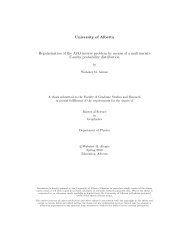Soner Bekleric Title of Thesis: Nonlinear Prediction via Volterra Ser
Soner Bekleric Title of Thesis: Nonlinear Prediction via Volterra Ser
Soner Bekleric Title of Thesis: Nonlinear Prediction via Volterra Ser
Create successful ePaper yourself
Turn your PDF publications into a flip-book with our unique Google optimized e-Paper software.
4.1. LINEAR PREDICTION IN THE F − X DOMAIN 48<br />
An ARMA model can be approximated by a long autoregressive model (AR), which<br />
turns out to be a representation <strong>of</strong> the linear prediction problem. In summary, linear<br />
events in t−x space transform into complex sinusoids in the f −x domain and linear<br />
prediction filtering can properly model the spatial variability <strong>of</strong> the waveforms at<br />
any given monochromatic temporal frequency f.<br />
The seismic signal is considered to be an AR model; let us assume a single<br />
waveform in time domain. In addition, let’s assume that the signal has linear<br />
moveout<br />
s(x, t) = a(t − xθ) (4.1)<br />
where x is <strong>of</strong>fset <strong>of</strong> the trace, t is the time and θ is the slowness <strong>of</strong> the event. In<br />
the frequency domain this signal becomes<br />
S(x, f) = A(f)e −i2πfθx<br />
(4.2)<br />
where A(f) denotes the source spectrum and f is the temporal frequency for x. By<br />
discretizing x = (j − 1)δx, f = fl<br />
Sjl = Ale −i2πflθ(j−1)δx<br />
(4.3)<br />
I can develop this model as a function <strong>of</strong> wave number by fixing kl = 2πflθ equation<br />
(4.3) becomes<br />
Sjl = Ale −ikl(j−1)δx<br />
(4.4)<br />
I can define the problem by predicting data along the each trace to fix temporal









